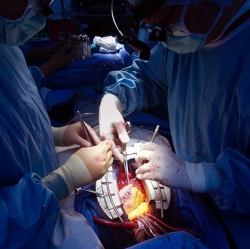
The idea is that companies can use the printed tissue to test whether experimental drugs are safe for human livers. Meanwhile, Organovo is building the knowledge it needs to print out larger patches of organ-specific tissue, which doctors could potentially graft onto ailing organs in the future.
"If you could get to something large enough to get to, for example, 10 percent of an organ’s function, it can significantly benefit the patient," says CEO Keith Murphy. Organovo is working on early animal tests for its organ patches.
As we reported in 2013, the sci-fi goal for research like Organovo’s is to print full organs that would be available for transplants one day. "I believe that could happen in my lifetime," chief technology officer Sharon Presnell told Popular Science at the time.
Why this stop in teeny livers along the way? Liver-safety tests are an essential part of testing new drugs. The liver is the body’s natural detoxifier, so nearly every drug a person takes eventually makes its way there. Normally, labs and companies perform liver-safety tests in lab rats and in single layers of liver cells called hepatocytes, grown in Petri dishes.
Tests in rats and Petri dishes don’t always reflect what happens when a human takes a drug, however. The most common reason that new drugs are later recalled is because they harm the liver in ways that researchers didn’t expect from their lab experiments.
Organovo thinks its 3-D printed livers can provide a better picture of how drugs interact with human livers. 3-D printing helps researchers build living tissues one cell at a time. Organovo took advantage of this to build model livers that have three different types of cells that appear in actual human livers.
There are hepatocytes; stellate cells, the second most common cell type in the liver after hepatocytes; and endothelial cells, which line blood vessels in real livers. In the mini-livers, the endothelial cells make channels that carry the nutritional liquid the research.
